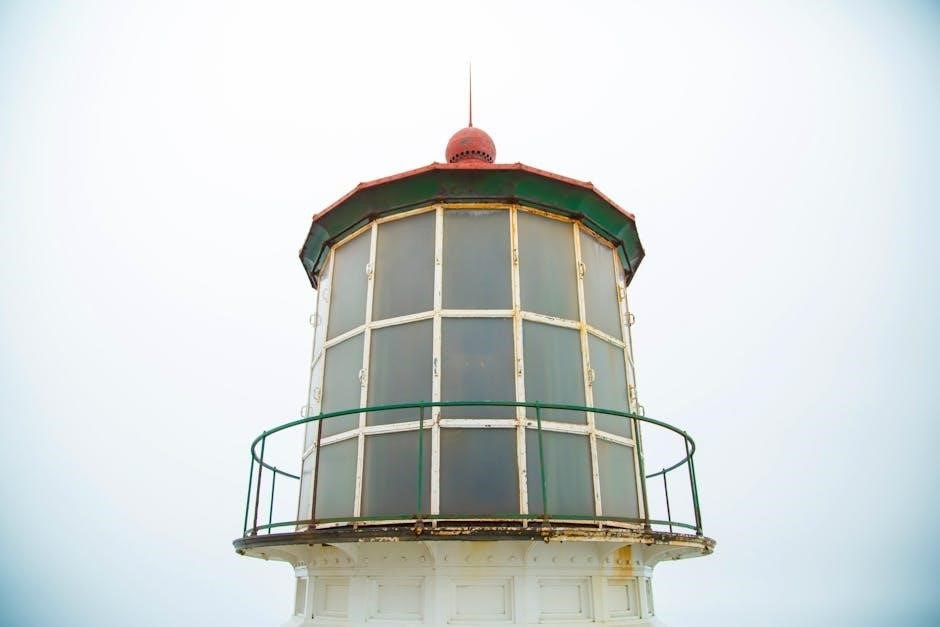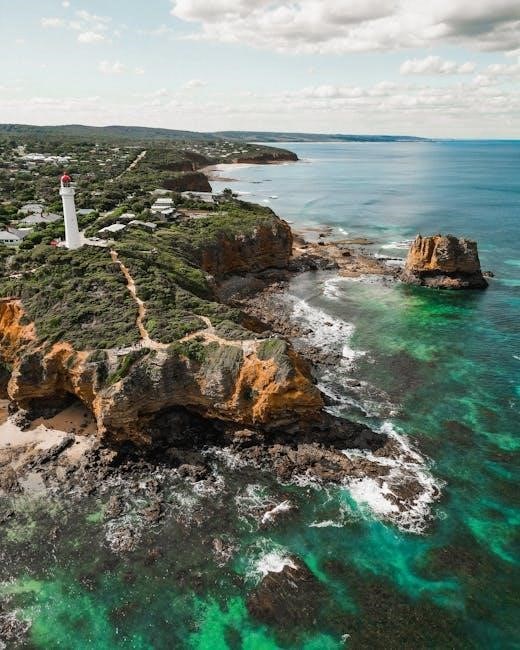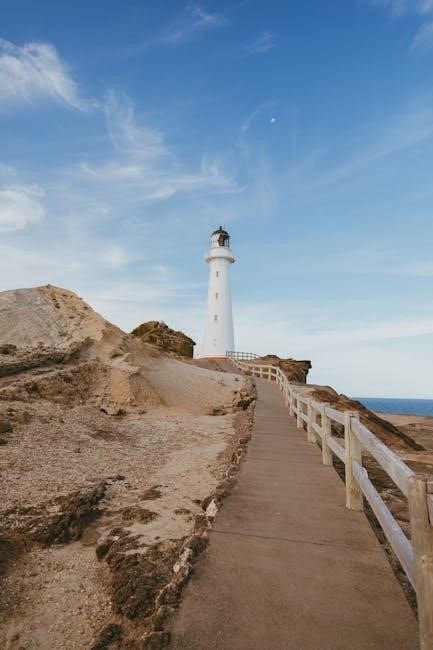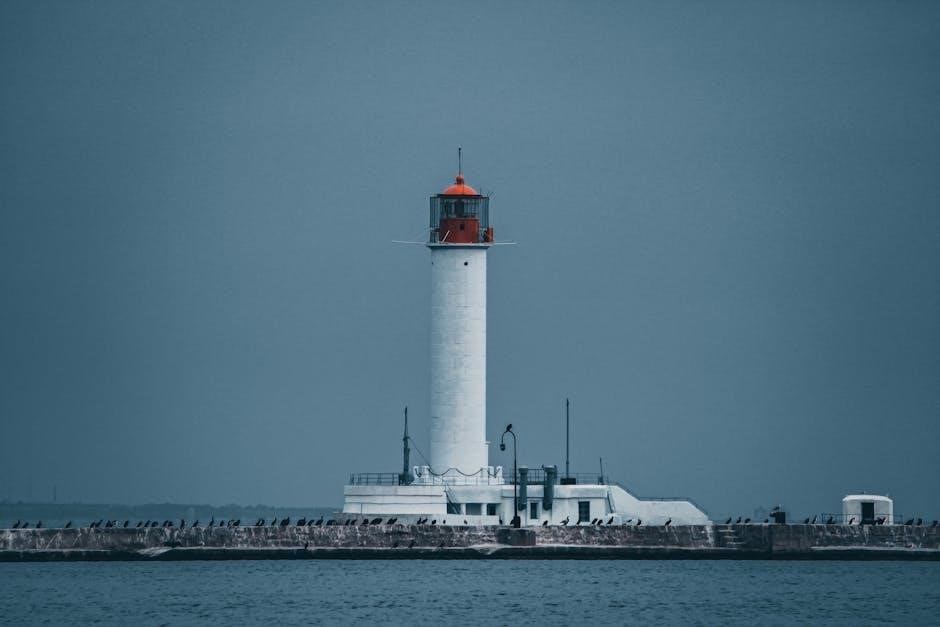A water softener is a system designed to remove calcium and magnesium ions from water, reducing hardness. It uses ion exchange technology to replace these ions with sodium or potassium, improving water quality and reducing scaling in pipes and appliances.
1.1 What is a Water Softener?
A water softener is a system designed to address water hardness by removing calcium and magnesium ions. It typically uses ion exchange technology, replacing these ions with sodium or potassium. This process reduces scaling in pipes and appliances, improving water quality for household use. Water softeners are essential for homes with hard water, as they prevent mineral buildup and enhance the effectiveness of cleaning products. They come in various types, including salt-based and salt-free systems, catering to different needs and preferences. Understanding how a water softener works is key to maintaining optimal water quality.
1.2 Benefits of Using a Water Softener
Using a water softener offers numerous benefits, including reduced scaling in pipes and appliances, softer skin and hair, and improved cleaning efficiency. It prevents mineral buildup, extending the lifespan of plumbing and water-using devices. Soft water enhances the effectiveness of detergents and soaps, reducing the need for harsh chemicals. Additionally, it can lower energy bills by improving appliance efficiency and reduce maintenance costs. Overall, a water softener enhances water quality, making it more comfortable and convenient for daily use while protecting your home’s infrastructure.

Pre-Installation Checklist
Assess your water supply, choose a suitable location, and gather necessary tools. Ensure the softener is not placed near extreme heat sources or freezing areas.
2.1 Understanding Your Water Supply
Assessing your water supply is crucial for proper installation. Determine if your water is from a well or city supply, as this affects placement and connections. For well systems, install the softener near the pressure tank, while city water systems should place it close to the water meter. Ensure the softener is upstream of all plumbing fixtures to condition all water effectively. Avoid installing near boilers or areas prone to freezing to prevent damage and maintain efficiency.
2.2 Choosing the Right Location for Installation
Selecting the ideal location for your water softener is essential for optimal performance. Place it near the main water supply line, either close to the water meter for city water or the pressure tank for well systems. Avoid installing near boilers or areas exposed to excessive heat or freezing temperatures. Ensure the location allows easy access for maintenance and is close to a drain for the wastewater discharge. Proper positioning ensures efficient operation and protects the system from potential damage, while also keeping it out of the way of daily activities.
2.3 Necessary Tools and Materials
For a successful installation, gather essential tools and materials. You’ll need a pipe cutter or tubing cutter, wrenches (adjustable and box-end), screwdrivers, and thread tape for secure connections. Materials include PEX tubing or copper pipes, fittings, and connectors. Ensure you have the correct adapters for your system. A drain line kit and bypass valve are also necessary. Optional items include a water test kit to measure hardness and a bypass valve installation kit. Always consult your specific system’s manual for any additional requirements to ensure a smooth setup process.
Step-by-Step Installation Guide
Follow a systematic approach to install your water softener: shut off water supply, connect the bypass valve, attach inlet/outlet ports, install the drain line, and connect to power.
3.1 Shutting Off the Water Supply
Begin by locating the main water shut-off valve, typically near the water meter or where the supply enters your home. Turn the valve clockwise to stop water flow. Open a few faucets to drain the system completely. Verify water is off by checking for leaks or water flow. This step is crucial to prevent water damage or flooding during installation. Ensure all taps are closed before proceeding. If unsure, consult a professional to avoid complications. Properly shutting off the supply ensures a safe and mess-free installation process.
3.2 Connecting the Bypass Valve
The bypass valve allows you to divert water flow around the softener during maintenance or regeneration; Attach the valve to the softener’s inlet and outlet ports using thread tape for a leak-free seal. Ensure the valve is in the “bypass” position before connecting water lines. Connect the main water supply to the inlet side and the house supply to the outlet side; Double-check all connections for tightness and proper alignment. This setup enables easy servicing without disrupting water access, ensuring continuous water supply when needed most.
3.3 Attaching the Inlet and Outlet Ports
Connect the inlet port to the main water supply line and the outlet port to the house plumbing. Use thread tape on all connections for a watertight seal. Ensure the inlet is linked to the incoming water and the outlet directs softened water to your home. Avoid cross-connections to prevent contamination. Tighten all fittings securely but avoid overtightening, which may damage threads. This step ensures the softener receives and distributes water correctly, maintaining proper flow and pressure throughout your plumbing system.
3.4 Installing the Drain Line
Connect the drain line from the water softener to a suitable drain point, ensuring it slopes downward to prevent water pooling. Use PVC or flexible tubing, securing it with clamps. Avoid routing near electrical components or heat sources. Install a drain trap or check valve if required to prevent backflow. Keep the line as short as possible and avoid sharp bends. Test the drain by running a regeneration cycle to ensure proper water flow. Ensure compliance with local plumbing codes for safe disposal of backwash water.
3.5 Connecting to the Power Supply
Plug the water softener into a nearby grounded electrical outlet. Ensure the outlet meets the system’s voltage requirements, typically 120V. Avoid using extension cords to prevent potential hazards. Turn on the power and check for any error messages on the control panel. Refer to the user manual for specific electrical connections and settings. Ensure the power supply is stable and protected from power surges for optimal performance. If unsure, consult a licensed electrician to ensure safe and proper installation.
3.6 Finalizing the Plumbing Setup
After connecting all components, inspect the plumbing for leaks. Turn the water supply back on slowly to check connections. Ensure the bypass valve is in the correct position. Verify that water flows correctly through the softener and to household fixtures. Test the system by running water through a faucet to ensure proper operation. If leaks or issues arise, tighten connections or consult the manual for troubleshooting steps. Proper setup ensures efficient water softening and prevents future maintenance issues.
Configuration and Settings
4.1 Programming the Water Softener
Programming your water softener involves setting the system to regenerate based on water usage. Enter the hardness level and preferred regeneration time. Most systems allow manual or automatic regeneration. Use the control panel to input data, ensuring optimal performance. Regularly review and adjust settings as water usage changes. Proper programming ensures efficient salt use and consistent water softening.
4.2 Adjusting Salt Levels
Adjusting salt levels ensures optimal performance of your water softener. Check the salt level in the brine tank regularly, typically once a month. Add salt when the level drops below the recommended mark. Use high-quality salt, such as pellet or solar salt, to prevent issues like salt bridges. Avoid overfilling, as this can cause system malfunctions. Maintain the salt level just above the waterline to ensure proper brine solution creation. Incorrect salt levels can lead to inefficient softening or damage to the system over time.
4.3 Setting the Regeneration Cycle
Setting the regeneration cycle ensures your water softener operates efficiently. Consult your user manual for specific instructions, as settings vary by model. Most systems have a default cycle, but you can adjust it based on water usage. Set the cycle to regenerate when water demand is low, typically at night. Ensure the timer aligns with your household’s water consumption patterns. Some models offer manual override for immediate regeneration. Monitor the system to confirm the cycle runs correctly and adjust as needed to maintain optimal water softening performance.

Maintenance and Upkeep
Regular maintenance ensures optimal performance. Check salt levels, clean filters, and inspect connections. Refer to your manual for specific guidance to keep your system running smoothly.
5.1 Daily Checks for Optimal Performance
Daily checks ensure your water softener operates efficiently. Monitor salt levels to avoid depletion, inspect the bypass valve for leaks, and verify proper water flow. Listen for unusual noises, as they may indicate internal issues. Regularly test water hardness to confirm softening effectiveness. Check the drain line for blockages to prevent backflow. Addressing these issues promptly helps maintain system performance and prevents costly repairs. A well-maintained softener ensures softened water throughout your home consistently. Always refer to your user manual for specific maintenance recommendations tailored to your model.
5.2 Cleaning and Replacing Filters
Regular filter maintenance is crucial for optimal water softener performance. Start by turning off the water supply and locating the filter, usually near the inlet. Clean or replace the filter as needed, ensuring no debris obstructs water flow. For sediment or carbon filters, flush thoroughly after cleaning. Replace filters every 6-12 months or as recommended by the manufacturer. Use a soft brush to remove dirt and rinse with clean water. Proper filter care prevents contaminants from affecting water quality and system efficiency, ensuring softened water remains clean and reliable. Always follow manufacturer guidelines for specific filter types.
5.3 Refilling Salt and Monitoring Usage
Regularly refilling salt in your water softener is essential for maintaining optimal performance. Check the salt level in the brine tank monthly and refill when it drops below the recommended level. Use high-quality salt or potassium chloride to ensure efficiency. Monitor water usage patterns to adjust salt dosage settings. Low salt levels can lead to ineffective water softening and potential system damage. Keep the brine tank clean and avoid overfilling to prevent salt bridges. Proper salt management ensures consistent water quality and extends the system’s lifespan, saving you from costly repairs and maintaining soft water benefits.
5.4 Annual Maintenance Tasks
Performing annual maintenance ensures your water softener operates efficiently. Clean the brine tank by dissolving and rinsing away residual salt. Check for salt bridges or blockages and break them up if necessary. Inspect the system’s valves, hoses, and connections for leaks or wear. Run a manual regeneration cycle to flush out built-up minerals. Replace any worn-out parts, like the resin bed or seals, to maintain performance. Schedule a professional inspection if needed to address complex issues. Regular upkeep prevents malfunctions and extends the system’s lifespan, ensuring consistent water softening and protecting your home’s plumbing.

Troubleshooting Common Issues
Troubleshooting common issues with your water softener involves identifying problems like low water pressure, salt bridges, or improper softening. Regular checks can help resolve these efficiently.
6.1 Low Water Pressure After Installation
Low water pressure after installing a water softener can occur due to restricted flow in the system. Check for kinked or improperly sized pipes, clogged filters, or faulty valves. Ensure all connections are secure and not obstructed. Verify that the bypass valve is fully open. If issues persist, inspect the softener’s internal components for blockages or mineral buildup. Regular maintenance, such as cleaning filters and replacing worn parts, can prevent pressure drops and maintain optimal water flow.
6.2 Salt Bridge or Clogged Salt Tank
A salt bridge occurs when salt crystallizes, forming a hard layer at the top of the brine tank, preventing the water softener from regenerating properly. This issue can disrupt the ion exchange process. To resolve it, carefully break the salt bridge using a plastic tool or broom handle. Dissolve any remaining salt chunks in warm water, then refill the tank with the recommended salt type. Regularly inspect and clean the salt tank to prevent future clogs and ensure optimal system performance.
6.3 Leaks in the Drain Line or Connections
Leaks in the drain line or connections can occur due to loose fittings, damaged tubing, or blockages. Inspect all connections and tighten any loose parts. If the drain line is damaged, replace it with a new one. Ensure the drain tubing is not kinked or obstructed. Regularly check for blockages in the drain system, such as debris or mineral buildup, and clear them promptly. After repairs, run a regeneration cycle to confirm the system operates leak-free and functions properly.
6.4 System Not Softening Water Properly
If your water softener isn’t softening water, check salt levels first. Low salt or a salt bridge can prevent proper regeneration. Ensure the system is programmed correctly, with the right hardness setting. Inspect for blockages in the resin tank or valves. A malfunctioning valve or incorrect regeneration cycle may also cause issues. Run a manual regeneration cycle and verify water hardness. If problems persist, professional servicing may be needed to address potential internal damage or software malfunctions.

Best Practices for Water Softener Use
Regularly monitor salt levels, adjust settings based on water usage, and maintain optimal hardness levels. Ensure proper system maintenance to enhance efficiency and longevity of the softener.
7.1 Conserving Water with a Softener
Using a water softener can impact water consumption, as regeneration cycles use water. To conserve water, adjust settings to minimize unnecessary regeneration; Regular maintenance ensures efficiency and prevents excess water waste. Fixing leaks promptly and using water-efficient appliances further reduce overall consumption. By optimizing your softener’s performance and adopting water-saving habits, you can enjoy softened water while minimizing its environmental impact and lowering utility bills.
7.2 Monitoring Water Hardness Levels
Regularly monitoring water hardness levels ensures your softener operates efficiently. Test your water hardness using a test kit or consult a professional. Adjust the softener settings based on the results to maintain optimal performance. Lower hardness levels reduce salt usage and energy consumption. Consistent monitoring prevents over-softening, which can waste resources. By keeping track of water hardness, you ensure your system works effectively and prolong its lifespan while maintaining water quality.
7.3 Upgrading Your Water Softener System
Upgrading your water softener system enhances performance and efficiency. Consider advanced models with smart technology for remote monitoring and optimized salt usage. High-capacity systems are ideal for large households or high water usage. Eco-friendly options reduce salt discharge and energy consumption. When upgrading, ensure compatibility with your existing plumbing and electrical setup. A professional installation is recommended for complex systems. Regular maintenance after the upgrade ensures longevity and optimal water quality, making it a worthwhile investment for your home’s water needs and environmental impact.

Environmental Considerations
Water softeners impact the environment through salt discharge and energy use. Eco-friendly systems reduce salt waste, while proper disposal of old units prevents hazardous material contamination.
8.1 Salt Usage and Its Impact
Water softeners use salt to remove minerals, producing brine wastewater. Excessive salt discharge can harm aquatic ecosystems and contaminate soil. High sodium levels in water systems may also affect plants and wildlife. Efficient salt usage is crucial to minimize environmental impact. Eco-friendly alternatives, like potassium-based systems, offer lower ecological footprints. Proper disposal of salt and old systems ensures environmental safety. Regular maintenance and upgrading to eco-conscious models help reduce long-term effects. Balancing water softening needs with environmental care is essential for sustainable practices.
8.2 Proper Disposal of Old Systems
Dispose of old water softeners responsibly to protect the environment. Many components, like metal and resin, can be recycled. Check local regulations for hazardous waste guidelines, as some parts may contain materials requiring special handling. Drain brine tanks and disconnect electrical components safely. Do not dump systems in landfills without proper preparation. Consider donating functional units or contacting recycling centers. Improper disposal can harm ecosystems and soil quality. Always follow community-specific instructions for safe and eco-friendly disposal of water softener systems.

Comparing Different Water Softener Systems
Compare salt-based, salt-free, ion exchange, and magnetic systems. Salt-based offers high efficiency, while salt-free is eco-friendly. Ion exchange is reliable, and magnetic systems require minimal maintenance, suited for small homes.
9.1 Salt-Based vs. Salt-Free Systems
Salt-based water softeners use ion exchange to remove hardness ions, replacing them with sodium or potassium, offering high efficiency and effective softening. Salt-free systems, however, crystallize minerals, preventing scaling without adding salt. Salt-based systems require regular salt replenishment and may increase sodium levels in water, while salt-free systems are eco-friendly and low-maintenance. Consider water hardness levels, maintenance preferences, and environmental impact when choosing between these options for optimal performance tailored to your home’s needs and local water conditions.
9.2 ion Exchange vs. Magnetic Systems
9.2 Ion Exchange vs. Magnetic Systems
Ion exchange systems remove hardness ions by exchanging calcium and magnesium for sodium or potassium, offering effective softening. Magnetic systems, however, use magnetic fields to alter mineral properties, preventing scaling without chemical changes. Ion exchange is proven for severe hardness but requires maintenance and salt. Magnetic systems are low-maintenance and eco-friendly but may not be as effective for very hard water. Choose based on water hardness, maintenance preferences, and desired results to ensure the best solution for your home’s water quality needs and environmental considerations.

FAQs and User Concerns
- How long does installation take? Typically 2-4 hours for a basic setup.
- Can I install it myself? Yes, but plumbing skills are recommended.
- What are the costs? Prices range from $500 to $11,000, depending on complexity.
10.1 How Long Does Installation Take?
Installation time varies depending on the system complexity and installer expertise. Basic water softener setups typically take 2-4 hours, while more complex installations may require up to 8 hours. Factors influencing duration include the need for plumbing modifications, electrical connections, and bypass valve assembly. DIY installations may take longer for inexperienced homeowners, while professional installations are generally quicker and more efficient. Planning and preparation, such as measuring and cutting pipes, can also add to the overall time required.
10.2 Can I Install the System Myself?
Installing a water softener yourself is possible if you have basic plumbing skills and tools. DIY installation can save costs, but it requires careful planning and adherence to the manufacturer’s instructions. Ensure you have the necessary materials, such as thread tape, wrenches, and drain tubing. If you’re unsure about plumbing modifications or electrical connections, hiring a professional is recommended to avoid system damage or safety risks. Proper installation ensures optimal performance and longevity of the softener.
10.3 What Are the Costs of Installation?
Installation costs for a water softener vary depending on complexity and location. Basic systems may cost between $500 to $700 for DIY kits, while professional installations range from $150 to $1,100 or more for whole-home setups. Labor rates can vary, with difficult installations potentially reaching up to $11,000. Some providers offer packages including supply and installation with extended warranties, which can impact the total cost. Always compare quotes and consider long-term maintenance expenses when budgeting for your water softening system.

Warranty and Support Information
Most water softeners come with a standard warranty covering parts and labor for several years. Contact customer support for assistance with repairs, replacements, or general inquiries.
11.1 Understanding Your Warranty Coverage
Warranty coverage for water softeners typically includes parts and labor for a specified period, often ranging from 5 to 10 years. This coverage usually applies to defects in materials and workmanship. Some extended warranties may cover additional components or provide longer protection. It’s essential to review your warranty document to understand what is included and any conditions that might void the coverage. Proper installation and maintenance are often required to keep the warranty valid. Always check the manufacturer’s terms for specific details.
11.2 Contacting Customer Support
For assistance with your water softener, contact customer support through the manufacturer’s official website or phone number. Many companies offer 24/7 support for troubleshooting issues like low water pressure or salt bridge problems. Before reaching out, have your system’s model number and warranty information ready. You can also refer to the user manual for guidance on common issues. Some manufacturers provide online chat or email options for convenience. Ensure you contact authorized support to receive accurate and reliable help for your water softener system.

Future Trends in Water Softening Technology
Future trends include smart water softeners with IoT connectivity for remote monitoring and AI-driven optimization. Eco-friendly solutions, like salt-free systems, are gaining popularity for sustainability and efficiency.
12.1 Smart Water Softeners
Smart water softeners represent a significant advancement in water treatment technology. These systems are equipped with Wi-Fi connectivity, allowing users to monitor and control settings via smartphone apps. Advanced sensors detect water usage patterns and adjust softening cycles accordingly. AI-driven algorithms optimize salt dosage and regeneration times, enhancing efficiency. Some models offer voice control through smart home systems like Alexa or Google Home. Real-time notifications alert users to low salt levels or system issues. This integration of technology ensures better water quality, reduced maintenance, and improved energy efficiency, making smart softeners a future-forward solution for modern homes.
12.2 Eco-Friendly Innovations
Eco-friendly innovations in water softening focus on reducing environmental impact. Salt-free systems now use advanced filtration to remove minerals without adding sodium. Some models incorporate recyclable components and energy-efficient designs. Low-water regeneration cycles minimize water waste. Additionally, systems now use biodegradable resin cleaners, reducing chemical discharge. These advancements aim to balance water softening needs with environmental sustainability, offering homeowners greener options without compromising performance. Such innovations align with global efforts to reduce waste and promote eco-conscious living, making water softening more accessible and responsible for future generations.
